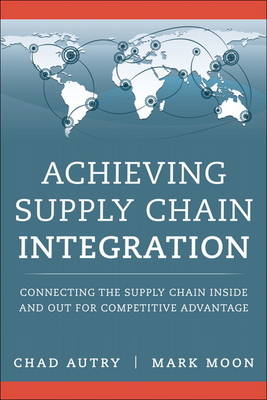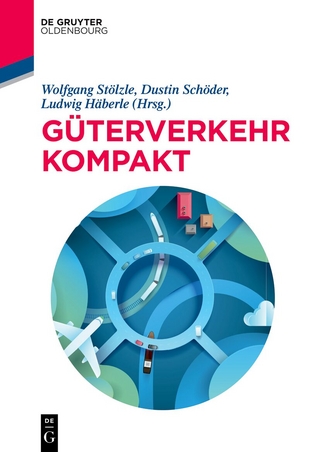
Achieving Supply Chain Integration
Pearson FT Press (Verlag)
978-0-13-421052-0 (ISBN)
- Titel ist leider vergriffen;
keine Neuauflage - Artikel merken
New research, practical priorities, actionable solutions
Master new best practices for integrating demand, supply, and partners worldwide
Bridge key “integration gaps” to maximize customer value and profit
Improve performance in areas ranging from resource availability to returns
From leading supply chain integration experts at the University of Tennessee’s Haslam College of Business
In volatile, global environments, only well-integrated organizations can deliver superior customer outcomes and sustained profitability. Supply chain practitioners are on the frontlines of integration: they must bring together functions ranging from sales to logistics and a world of third-party suppliers. Integration is not easy, but proven solutions exist. In Achieving Supply Chain Integration, leading experts reveal what works and how to make it work.
The authors and contributors clarify what supply chain integration really means, and why it’s even more crucial than many companies realize. You’ll learn how to manage core conflicts that make integration difficult, so you can maximize value to both customers and your organization.
You’ll find example-based, research-driven insights for both internal and external integration, addressing issues ranging from culture to financial metrics. The authors share practical guidance on everything from building more innovative partner relationships to avoiding raw material shortages.
Whatever your supply chain or operations responsibilities, you need to integrate more effectively, and this guide will help you do it.
Supply chain integration can ensure a smoother, more efficient flow of products, and enable access to third-party resources and capabilities that would be costly or impossible to build internally. However, successful integration has proven challenging, especially as supply chains evolve to encompass even more external partners.
The Department of Marketing and Supply Chain Management at the University of Tennessee’s Haslam College of Business has focused extensively on researching successful integration across demand, supply, and inter-enterprise functions. Now, its pioneering researchers share indispensable new insights on making integration work throughout your supply chain.
Achieving Supply Chain Integration shows how to prioritize which processes and functions to integrate and select integration strategies likely to deliver the greatest performance benefits. Drawing on actual successes and failures, UT’s researchers illuminate best practices and common mistakes. They present proven approaches to integrating sales, marketing, core supply chain functions such as procurement and logistics, and widely diverse partner relationships.
Whether you’re a practitioner or student, this guide will help you approach integration projects with “eyes open”—so you can mitigate risks and maximize value.
Understanding what integration is and isn’t, and why it matters so much
Bridging the integration gap to maximize value creation
Fully leveraging information in internal and external integration
Driving more value by integrating purchasing and logistics
Aligning market, environmental, social, and political strategies
Achieving deeper demand/supply integration
Reducing product returns through better internal integration
Building more innovative, collaborative supplier relationships
Dr. Chad W. Autry is the William J. Taylor Professor of Supply Chain Management in the Haslam College of Business at the University of Tennessee. Dr. Autry’s professional background includes several years’ experience in retail and restaurant operations management. He has worked with and for numerous professional, civic, and governmental organizations related to supply chain process improvement, and has served in leadership positions for the Council of Supply Chain Management Professionals (CSCMP), on the national Board of Directors of the Warehouse Education and Research Council (WERC), and on the local board of the National Association of Purchasing Managers (NAPM). Dr. Autry’s research focuses primarily on socially responsible and collaborative interfirm and interfunctional relationships, their integration within and across firms, and the technological and social issues that support connectivity across multiple organizations simultaneously. He is author of over 70 research studies published in academic and professional outlets including the Journal of Business Logistics, Journal of Operations Management, Journal of Retailing, Journal of Management, International Journal of Logistics Management, and Strategic Management Journal. He is a co-author of the recent book, Global Macrotrends and Their Impact on Supply Chain Management, published by Pearson/Financial Times Press. Dr. Autry is Editor in Chief of the Journal of Supply Chain Management and serves as Associate Editor for the Journal of Business Logistics, Decision Sciences Journal, and Logistique’ Management, in addition to editorial board responsibilities for several other academic and managerial publications. Dr. Mark A. Moon is an Associate Professor of Marketing at the University of Tennessee’s Haslam College of Business and former Head of the Department of Marketing and Supply Chain Management. Prior to joining the Haslam faculty in 1993, Dr. Moon earned his PhD from the University of North Carolina at Chapel Hill. He also holds MBA and BA degrees from the University of Michigan in Ann Arbor. Dr. Moon’s professional experience includes positions in sales and marketing with IBM and Xerox. He teaches at the undergraduate, MBA, and Executive MBA levels, and teaches demand planning, forecasting, and marketing strategy in numerous executive programs offered at the Haslam College of Business. Dr. Moon’s primary research interests are in Sales and Operations Planning (S&OP), demand forecasting, and buyer/seller relationships. He has published in many of the field’s leading journals and conference proceedings. He authored Demand and Supply Integration: The Key to World Class Demand Forecasting, and Sales Forecasting Management: A Demand Management Approach with Dr. John T. (Tom) Mentzer. His consulting clients have included Honeywell, Goodyear, Corning, Walgreens, Whirlpool, Lockheed-Martin, and many other firms.
Preface viii
Chapter 1: Integration: What It Is, What It Isn’t, and Why You Should Care 1
Integration and Supply Chain Management 4
What Factors Lead to Integration? 6
What Are Integration’s Performance Implications? 7
Solidifying Our Understanding of Integration 8
Toward Consensus on Cross-Functional Integration 10
Extending Previous Definitional Work on Integration 15
Planting the Seeds for Integration 18
Tools Available to Managers 21
Conclusion 24
Endnotes 25
Chapter 2: Bridging the Integration Gap 27
The Difficulty in Integrating 30
Interfunctional Bias 31
General Methods for Overcoming Conflict Within Integration 32
Interest-Based Problem Solving and Collaborative Communication 35
Conclusion 45
Endnotes 46
Chapter 3: Maximizing Organizational Value Creation Across the Great Divide 47
The Demand and Supply Integration Journey 50
Four Examples of the DSI Journey 53
Managerial Implications 68
Conclusions 75
About the Research 75
Endnotes 77
Chapter 4: The Role of Information in Internal and External Integration 79
The Importance of IT Infrastructure Integration to Supply Chain Effectiveness 80
The Role of Operating Models in Relation to Integration 82
Conclusions 85
Endnotes 88
Chapter 5: Bending the Chain: Deriving Value from Purchasing-Logistics Integration 89
The Surprising Challenge: Purchasing and Logistics Integration 93
Supply and Demand Disconnects 96
The Research: Linking Purchasing and Logistics Integration (PLi) to Improved Functional and Financial Performance 98
Best Practices 107
Seven Actions a Supply Chain Leader Can Take Today 118
How High Is Your PLi? 120
Endnotes 122
Chapter 6: Getting Aligned: The Benefits of Integrating Market, Environmental, Social, and Political Strategies Within the Organization 123
How Do Executives Engage in Strategic Management? 125
The Alignment Framework 127
Applying the Alignment Framework 129
Integrating Market and Nonmarket Strategies 136
Conclusion 144
Endnotes 144
Chapter 7: Achieving Demand and Supply Integration 147
The Idea Behind DSI 148
How DSI Is Different from S&OP 149
Signals That Demand and Supply Are Not Effectively Integrated 151
The Ideal Picture of Demand and Supply Integration 152
DSI Across the Supply Chain 157
Typical DSI Aberrations 160
DSI Core Principles 164
Critical Components of DSI 166
Characteristics of Successful DSI Implementations 172
DSI Summary 175
Endnotes 175
Chapter 8: Sell Right, Not More: Leveraging Internal Integration to Mitigate Product Returns 177
A Returns Management Overview: Inspiring Internal Integration 178
The Challenge of Managing Returns 190
Thoughts and Observations 200
Endnotes 201
Chapter 9: Supplier Integration via Vested Relationships 203
The Sourcing Continuum 204
Seven Sourcing Business Models 210
Supplier Integration via Vested Relationships 226
Conclusion 234
Endnotes 235
Chapter 10: Raw Material Feast or Famine: Integrating Supply Networks to Overcome Resource Scarcity 239
Supply Risk—It Is There, Whether You Manage It or Not 241
Understanding the Network of Risks 242
Managing the Network of Risks: Detection, Mitigation, and Recovery 243
Integration as an Enabler of Continuity and Resiliency 248
A Network Approach to Managing Supply Disruptions Through Integration 253
Natural Resource Scarcity and the Dynamic Global Supply Network 260
Conclusion 264
Endnotes 265
Chapter 11: Integrating Ideas and Environments: Blending Marketing Strategy with Context for Organizational Success 267
The Study: Integrating Marketing Strategy with a Firm’s Internal and External Conditions 273
Conclusion 293
Endnotes 294
Chapter 12: External Barriers to Integration: Tearing Down the Walls 297
Conceptualizing Integration 300
Defining the Types of Barriers 302
Concluding Thoughts 311
Endnotes 312
Index 313
| Erscheint lt. Verlag | 10.3.2016 |
|---|---|
| Verlagsort | NJ |
| Sprache | englisch |
| Maße | 100 x 100 mm |
| Gewicht | 100 g |
| Themenwelt | Technik ► Maschinenbau |
| Wirtschaft ► Betriebswirtschaft / Management ► Logistik / Produktion | |
| Wirtschaft ► Betriebswirtschaft / Management ► Unternehmensführung / Management | |
| ISBN-10 | 0-13-421052-2 / 0134210522 |
| ISBN-13 | 978-0-13-421052-0 / 9780134210520 |
| Zustand | Neuware |
| Haben Sie eine Frage zum Produkt? |
aus dem Bereich


